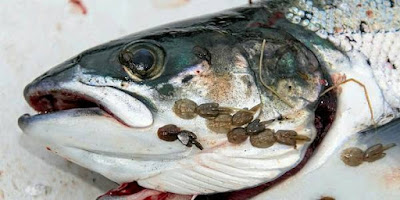6 JULY, 2019 - M/V SO...FEA DECK LOG - SEA LICE
ALTHOUGH WE ARE STILL DOWN COMPUTER-WISE, HERE IS AN OLDER EXCERPT TO KEEP YOU BUSY.... Over the 4th of July week-end, I saw some fish come in with lice, fisherman have no idea what these are... for millions of years Sea Lice have reinvented themselves to live on salmon, and other coastal type fish, feeding on the skin and blood to survive, although Lice have a short, free-swimming larval phase, they need to find and attach to a Salmon host, and begin life less than a millimeter in length.
Sea lice are able to invade schools or 'groups' of family fish, they act much like they do on on humans, when living in high densities, so, infestations spread more easily. Sea lice are able to settle-in and attach to fish and then grow into their pre-adult stage without the fish even being aware that they are there.
During the time when they are attached to a salmon, sea lice actively feed and “graze” on the skin and the outter tissues, and the mucous sub-layer of the fish skin. Once sea lice molt into their second growth stages they move and become more pathogenic, that is when blood can be detected in a fish’s gut, leading the sea lice to start feeding on the blood in the hosts innards.
During their attachment Sea lice secrete numbing compounds preventing a fish’s immune response from working properly, allowing even more Sea lice to settle on, and feed at their leisure.
Once fish mature, many things happen due to the damaged skin, the overall health of the fish degrades, the fish goes into distress, eats less, becomes lethargic (and easier to catch), the diseased skin and immune system opens a portal to secondary infections linked to virus and bacteria in the flesh of the fish.
If you are not familiar in identifying a "sick" fish, be careful.
